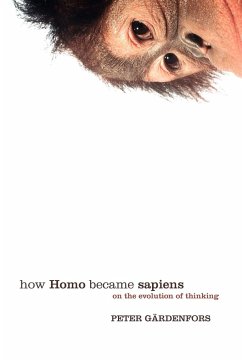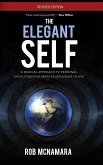- Broschiertes Buch
- Merkliste
- Auf die Merkliste
- Bewerten Bewerten
- Teilen
- Produkt teilen
- Produkterinnerung
- Produkterinnerung
In this entertaining work, Peter G¿enfors embarks on an evolutionary detective story to try and solve one of the big mysteries surrounding human existence - how has the modern human being's way of thinking come into existence. Immensely readable and full of humorous insights, the book will be valuable for students in psychology and biology, and accessible to readers of popular science.
Andere Kunden interessierten sich auch für
![Homo negatieve perceptie Homo negatieve perceptie]() Yafi Sabila RosyadHomo negatieve perceptie26,99 €
Yafi Sabila RosyadHomo negatieve perceptie26,99 €![Der unfertige Gott Der unfertige Gott]() Ilia DelioDer unfertige Gott32,00 €
Ilia DelioDer unfertige Gott32,00 €![Vorurteile Vorurteile]() Juliane DegnerVorurteile24,99 €
Juliane DegnerVorurteile24,99 €![A Human History of Emotion A Human History of Emotion]() Richard Firth-GodbehereA Human History of Emotion9,49 €
Richard Firth-GodbehereA Human History of Emotion9,49 €![The Elegant Self, A Radical Approach to Personal Evolution for Greater Influence in Life The Elegant Self, A Radical Approach to Personal Evolution for Greater Influence in Life]() Robert Lundin McNamaraThe Elegant Self, A Radical Approach to Personal Evolution for Greater Influence in Life37,99 €
Robert Lundin McNamaraThe Elegant Self, A Radical Approach to Personal Evolution for Greater Influence in Life37,99 €![The Moral Brain The Moral Brain]() Jan Verplaetse / Jelle de Schrijver / Sven Vanneste / Johan Braeckman (ed.)The Moral Brain194,99 €
Jan Verplaetse / Jelle de Schrijver / Sven Vanneste / Johan Braeckman (ed.)The Moral Brain194,99 €![Der Einzug des evolutionstheoretischen Ansatzes in die Emotionspsychologie Der Einzug des evolutionstheoretischen Ansatzes in die Emotionspsychologie]() Aaron FaßbenderDer Einzug des evolutionstheoretischen Ansatzes in die Emotionspsychologie16,95 €
Aaron FaßbenderDer Einzug des evolutionstheoretischen Ansatzes in die Emotionspsychologie16,95 €-
-
-
In this entertaining work, Peter G¿enfors embarks on an evolutionary detective story to try and solve one of the big mysteries surrounding human existence - how has the modern human being's way of thinking come into existence. Immensely readable and full of humorous insights, the book will be valuable for students in psychology and biology, and accessible to readers of popular science.
Hinweis: Dieser Artikel kann nur an eine deutsche Lieferadresse ausgeliefert werden.
Hinweis: Dieser Artikel kann nur an eine deutsche Lieferadresse ausgeliefert werden.
Produktdetails
- Produktdetails
- Verlag: OUP Oxford
- Seitenzahl: 252
- Erscheinungstermin: 12. Januar 2006
- Englisch
- Abmessung: 234mm x 156mm x 14mm
- Gewicht: 389g
- ISBN-13: 9780198528517
- ISBN-10: 0198528515
- Artikelnr.: 21305679
- Herstellerkennzeichnung
- Libri GmbH
- Europaallee 1
- 36244 Bad Hersfeld
- gpsr@libri.de
- Verlag: OUP Oxford
- Seitenzahl: 252
- Erscheinungstermin: 12. Januar 2006
- Englisch
- Abmessung: 234mm x 156mm x 14mm
- Gewicht: 389g
- ISBN-13: 9780198528517
- ISBN-10: 0198528515
- Artikelnr.: 21305679
- Herstellerkennzeichnung
- Libri GmbH
- Europaallee 1
- 36244 Bad Hersfeld
- gpsr@libri.de
1. Thinking from an evolutionary perspective
1.1: The human family tree
1.2: Enter Homo
1.3: What is to be explained: the components of thought
1.4: Four sources of empirical support
1.5: Early stages in the evolution of thought
1.6: Skinnerian beings
2. Sensation, perception and imagination
2.1: Sensations: being aware of the world
2.2: The art of aiming - why chimpanzees cannot throw darts
2.3: Perceptions: seeing the world
2.4: Categorical perception: sorting the world into boxes
2.5: Object permanence: the world outside our sensations
2.6: The art of chasing a mouse
2.7: Going between the senses
2.8: Causal reasoning: finding the invisible threads
2.9: A room with a view
2.10: Imagination: detaching the senses
3. The World Within
3.1: Popperian beings
3.2: Representations and the brain
3.3: Pretense: playing in the inner world
3.4: Directing thought: intentionality
3.5: Imitation - why apes cannot ape
3.6: Planning - why the squirrel does not plan for the winter
3.7: Ockham's razor
3.8: Thinking about tomorrow
3.9: Making tools
3.10: The human dilemma
4. Reading other people's minds
4.1: Levels of theory of mind
4.2: Understanding emotions
4.3: Understanding attention
4.4: Understanding intentions
4.5: Understanding what others know
4.6: Deception
4.7: Machiavellian intelligence
4.8: Autism: when there are gaps in the inner world
5. Self-consciousness
5.1: What is self-consciousness?
5,2: Animals for themselves: Why baboons do not wear lipstick
5.3: Communication, attention, and consciousness
5.4: It's not rude to point
5.5: You and I
5.6: The mirror of the soul
5.7: Free will
5.8: Consciousness and morality - why vervets are incapacitated
6. The dawn of language
6.1: Signals and symbols
6.2: ... and icons
6.3: Linguistic communication and higher-order intentions
6.4: Animals' linguistic capacity
6.5: Kanzi - at the brink of language
6.6: How children learn language
6.7: Miming as intentional communication
6.8: Keeping time - why chimps do not play in the circus orchestra
7. The origin of speech
7.1: Why just humans?
7.2: Consciousness and language
7.3: The gossip theory
7.4: Sharing visions for the future - co-operation begets language
7.5: Language as a social marker
7.6: Motherese
7.7: Proto-language
7.8: The role of grammar
7.9: Myths and narratives
7.10: Language in the brain
7.11: Where are the meanings of words?
8. Externalising the inner world
8.1: External memories
8.2: The development of writing
8.3: The influence of writing on thought
8.4: Science: the world of theories
8.5: Drifting thought - and the selfish meme
8.6: Detached identity
8.7: The open person
Epilogue
1.1: The human family tree
1.2: Enter Homo
1.3: What is to be explained: the components of thought
1.4: Four sources of empirical support
1.5: Early stages in the evolution of thought
1.6: Skinnerian beings
2. Sensation, perception and imagination
2.1: Sensations: being aware of the world
2.2: The art of aiming - why chimpanzees cannot throw darts
2.3: Perceptions: seeing the world
2.4: Categorical perception: sorting the world into boxes
2.5: Object permanence: the world outside our sensations
2.6: The art of chasing a mouse
2.7: Going between the senses
2.8: Causal reasoning: finding the invisible threads
2.9: A room with a view
2.10: Imagination: detaching the senses
3. The World Within
3.1: Popperian beings
3.2: Representations and the brain
3.3: Pretense: playing in the inner world
3.4: Directing thought: intentionality
3.5: Imitation - why apes cannot ape
3.6: Planning - why the squirrel does not plan for the winter
3.7: Ockham's razor
3.8: Thinking about tomorrow
3.9: Making tools
3.10: The human dilemma
4. Reading other people's minds
4.1: Levels of theory of mind
4.2: Understanding emotions
4.3: Understanding attention
4.4: Understanding intentions
4.5: Understanding what others know
4.6: Deception
4.7: Machiavellian intelligence
4.8: Autism: when there are gaps in the inner world
5. Self-consciousness
5.1: What is self-consciousness?
5,2: Animals for themselves: Why baboons do not wear lipstick
5.3: Communication, attention, and consciousness
5.4: It's not rude to point
5.5: You and I
5.6: The mirror of the soul
5.7: Free will
5.8: Consciousness and morality - why vervets are incapacitated
6. The dawn of language
6.1: Signals and symbols
6.2: ... and icons
6.3: Linguistic communication and higher-order intentions
6.4: Animals' linguistic capacity
6.5: Kanzi - at the brink of language
6.6: How children learn language
6.7: Miming as intentional communication
6.8: Keeping time - why chimps do not play in the circus orchestra
7. The origin of speech
7.1: Why just humans?
7.2: Consciousness and language
7.3: The gossip theory
7.4: Sharing visions for the future - co-operation begets language
7.5: Language as a social marker
7.6: Motherese
7.7: Proto-language
7.8: The role of grammar
7.9: Myths and narratives
7.10: Language in the brain
7.11: Where are the meanings of words?
8. Externalising the inner world
8.1: External memories
8.2: The development of writing
8.3: The influence of writing on thought
8.4: Science: the world of theories
8.5: Drifting thought - and the selfish meme
8.6: Detached identity
8.7: The open person
Epilogue
1. Thinking from an evolutionary perspective
1.1: The human family tree
1.2: Enter Homo
1.3: What is to be explained: the components of thought
1.4: Four sources of empirical support
1.5: Early stages in the evolution of thought
1.6: Skinnerian beings
2. Sensation, perception and imagination
2.1: Sensations: being aware of the world
2.2: The art of aiming - why chimpanzees cannot throw darts
2.3: Perceptions: seeing the world
2.4: Categorical perception: sorting the world into boxes
2.5: Object permanence: the world outside our sensations
2.6: The art of chasing a mouse
2.7: Going between the senses
2.8: Causal reasoning: finding the invisible threads
2.9: A room with a view
2.10: Imagination: detaching the senses
3. The World Within
3.1: Popperian beings
3.2: Representations and the brain
3.3: Pretense: playing in the inner world
3.4: Directing thought: intentionality
3.5: Imitation - why apes cannot ape
3.6: Planning - why the squirrel does not plan for the winter
3.7: Ockham's razor
3.8: Thinking about tomorrow
3.9: Making tools
3.10: The human dilemma
4. Reading other people's minds
4.1: Levels of theory of mind
4.2: Understanding emotions
4.3: Understanding attention
4.4: Understanding intentions
4.5: Understanding what others know
4.6: Deception
4.7: Machiavellian intelligence
4.8: Autism: when there are gaps in the inner world
5. Self-consciousness
5.1: What is self-consciousness?
5,2: Animals for themselves: Why baboons do not wear lipstick
5.3: Communication, attention, and consciousness
5.4: It's not rude to point
5.5: You and I
5.6: The mirror of the soul
5.7: Free will
5.8: Consciousness and morality - why vervets are incapacitated
6. The dawn of language
6.1: Signals and symbols
6.2: ... and icons
6.3: Linguistic communication and higher-order intentions
6.4: Animals' linguistic capacity
6.5: Kanzi - at the brink of language
6.6: How children learn language
6.7: Miming as intentional communication
6.8: Keeping time - why chimps do not play in the circus orchestra
7. The origin of speech
7.1: Why just humans?
7.2: Consciousness and language
7.3: The gossip theory
7.4: Sharing visions for the future - co-operation begets language
7.5: Language as a social marker
7.6: Motherese
7.7: Proto-language
7.8: The role of grammar
7.9: Myths and narratives
7.10: Language in the brain
7.11: Where are the meanings of words?
8. Externalising the inner world
8.1: External memories
8.2: The development of writing
8.3: The influence of writing on thought
8.4: Science: the world of theories
8.5: Drifting thought - and the selfish meme
8.6: Detached identity
8.7: The open person
Epilogue
1.1: The human family tree
1.2: Enter Homo
1.3: What is to be explained: the components of thought
1.4: Four sources of empirical support
1.5: Early stages in the evolution of thought
1.6: Skinnerian beings
2. Sensation, perception and imagination
2.1: Sensations: being aware of the world
2.2: The art of aiming - why chimpanzees cannot throw darts
2.3: Perceptions: seeing the world
2.4: Categorical perception: sorting the world into boxes
2.5: Object permanence: the world outside our sensations
2.6: The art of chasing a mouse
2.7: Going between the senses
2.8: Causal reasoning: finding the invisible threads
2.9: A room with a view
2.10: Imagination: detaching the senses
3. The World Within
3.1: Popperian beings
3.2: Representations and the brain
3.3: Pretense: playing in the inner world
3.4: Directing thought: intentionality
3.5: Imitation - why apes cannot ape
3.6: Planning - why the squirrel does not plan for the winter
3.7: Ockham's razor
3.8: Thinking about tomorrow
3.9: Making tools
3.10: The human dilemma
4. Reading other people's minds
4.1: Levels of theory of mind
4.2: Understanding emotions
4.3: Understanding attention
4.4: Understanding intentions
4.5: Understanding what others know
4.6: Deception
4.7: Machiavellian intelligence
4.8: Autism: when there are gaps in the inner world
5. Self-consciousness
5.1: What is self-consciousness?
5,2: Animals for themselves: Why baboons do not wear lipstick
5.3: Communication, attention, and consciousness
5.4: It's not rude to point
5.5: You and I
5.6: The mirror of the soul
5.7: Free will
5.8: Consciousness and morality - why vervets are incapacitated
6. The dawn of language
6.1: Signals and symbols
6.2: ... and icons
6.3: Linguistic communication and higher-order intentions
6.4: Animals' linguistic capacity
6.5: Kanzi - at the brink of language
6.6: How children learn language
6.7: Miming as intentional communication
6.8: Keeping time - why chimps do not play in the circus orchestra
7. The origin of speech
7.1: Why just humans?
7.2: Consciousness and language
7.3: The gossip theory
7.4: Sharing visions for the future - co-operation begets language
7.5: Language as a social marker
7.6: Motherese
7.7: Proto-language
7.8: The role of grammar
7.9: Myths and narratives
7.10: Language in the brain
7.11: Where are the meanings of words?
8. Externalising the inner world
8.1: External memories
8.2: The development of writing
8.3: The influence of writing on thought
8.4: Science: the world of theories
8.5: Drifting thought - and the selfish meme
8.6: Detached identity
8.7: The open person
Epilogue








